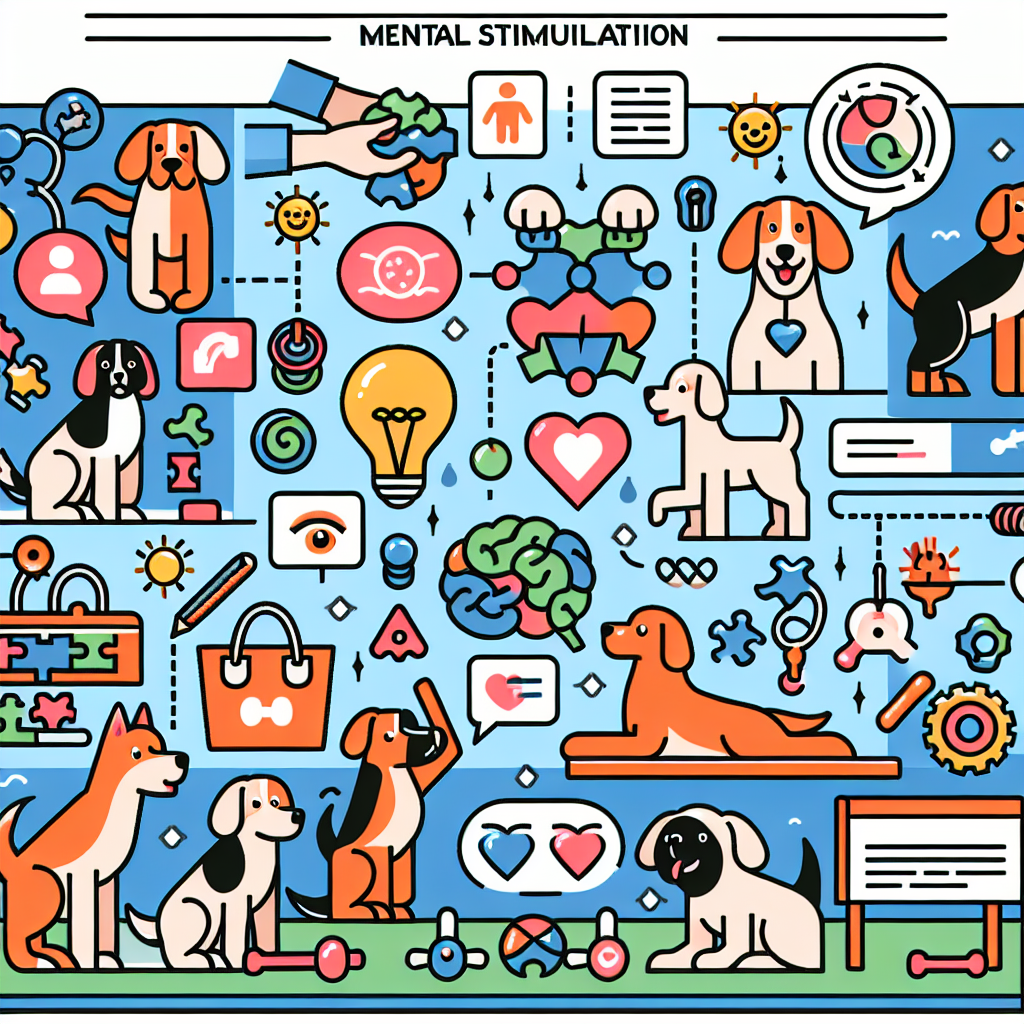The Importance of Mental Stimulation for Dogs
Table of Contents
Mental stimulation is crucial for the overall well-being of dogs, playing a significant role in their physical health, emotional stability, and behavioral development. Just like humans, dogs require mental challenges to keep their minds sharp and engaged. Without adequate mental stimulation, dogs can become bored, anxious, and even develop destructive behaviors. Engaging a dog’s mind through activities such as puzzle toys, training exercises, and interactive play not only prevents these negative outcomes but also strengthens the bond between the dog and its owner. Furthermore, mental stimulation can help in managing energy levels, reducing stress, and promoting a happier, more balanced life for our canine companions.
Benefits Of Mental Stimulation For Canine Health
Mental stimulation is a crucial aspect of canine health that often goes overlooked in favor of physical exercise. While taking dogs for walks and engaging them in physical activities are essential, mental stimulation plays an equally significant role in ensuring their overall well-being. The benefits of mental stimulation for dogs are manifold, impacting their cognitive functions, emotional health, and even their physical state.
To begin with, mental stimulation enhances cognitive functions in dogs. Just as humans benefit from activities that challenge their brains, dogs also thrive when they are mentally engaged. Puzzles, interactive toys, and training exercises that require problem-solving can significantly improve a dog’s cognitive abilities. These activities encourage dogs to think, learn, and adapt, which can be particularly beneficial for aging dogs. Cognitive decline is a common issue in older dogs, and mental stimulation can help delay the onset of conditions such as canine cognitive dysfunction, akin to Alzheimer’s disease in humans.
Moreover, mental stimulation contributes to emotional health by reducing stress and anxiety. Dogs that are mentally engaged are less likely to exhibit behavioral problems such as excessive barking, chewing, or digging. These behaviors often stem from boredom or pent-up energy, which can be alleviated through activities that challenge the mind. For instance, scent work or hide-and-seek games can keep dogs occupied and satisfied, thereby reducing the likelihood of destructive behaviors. Additionally, mental stimulation can help build a dog’s confidence, particularly in those that are shy or anxious. Successfully completing a challenging task can provide a sense of accomplishment and boost self-esteem.
In addition to cognitive and emotional benefits, mental stimulation also has a positive impact on a dog’s physical health. Engaging in mentally stimulating activities often requires physical movement, which can help maintain a healthy weight and improve overall fitness. For example, agility training not only challenges a dog’s mind but also provides a rigorous physical workout. Furthermore, mental stimulation can improve a dog’s coordination and balance, which are essential for physical agility and preventing injuries.
Another significant benefit of mental stimulation is the strengthening of the bond between dogs and their owners. Activities that require interaction, such as training sessions or playing with interactive toys, foster a deeper connection and mutual understanding. This bond is crucial for a dog’s sense of security and well-being. When dogs feel connected to their owners, they are more likely to be obedient and responsive, making training easier and more effective.
It is also worth noting that mental stimulation can be particularly beneficial for working breeds or highly intelligent dogs. These dogs have a natural inclination for tasks that challenge their minds, and without adequate mental engagement, they can become frustrated or depressed. Providing these dogs with appropriate mental challenges can fulfill their innate needs and lead to a more balanced and content life.
In conclusion, the importance of mental stimulation for dogs cannot be overstated. It enhances cognitive functions, supports emotional health, contributes to physical well-being, strengthens the bond between dogs and their owners, and is particularly beneficial for certain breeds. By incorporating mentally stimulating activities into a dog’s daily routine, owners can ensure a happier, healthier, and more fulfilled life for their canine companions.
Effective Ways To Provide Mental Stimulation For Dogs

Mental stimulation is crucial for the overall well-being of dogs, as it helps to keep their minds sharp, reduces behavioral issues, and enhances their quality of life. Providing mental stimulation for dogs can be achieved through various effective methods, each catering to different aspects of their cognitive needs. One of the most straightforward ways to engage a dog’s mind is through interactive toys. These toys often require the dog to solve a puzzle or perform a specific action to receive a reward, such as a treat. By challenging the dog to think and problem-solve, interactive toys can significantly reduce boredom and prevent destructive behaviors that often arise from a lack of mental engagement.
In addition to interactive toys, training sessions are another excellent way to provide mental stimulation. Training not only reinforces good behavior but also requires the dog to focus and learn new commands or tricks. This process of learning and repetition engages the dog’s brain, making it an effective mental exercise. Moreover, training sessions can be tailored to the dog’s individual needs and abilities, ensuring that the level of challenge is appropriate and beneficial.
Furthermore, incorporating scent work into a dog’s routine can be highly stimulating. Dogs have an extraordinary sense of smell, and engaging this sense can be both mentally and physically rewarding. Scent work can involve simple activities such as hiding treats around the house or yard for the dog to find, or more structured exercises like tracking and search-and-rescue games. These activities not only provide mental stimulation but also tap into the dog’s natural instincts, making them particularly satisfying.
Another effective method to stimulate a dog’s mind is through social interaction. Dogs are inherently social animals, and regular interaction with other dogs and humans can provide significant mental enrichment. Socialization opportunities can include playdates with other dogs, visits to dog parks, or participation in group training classes. These interactions help to develop a dog’s social skills and provide a variety of new experiences and challenges.
Additionally, providing a dog with a variety of experiences and environments can be mentally stimulating. Taking a dog on different walking routes, visiting new parks, or even going on car rides to different locations can expose the dog to new sights, sounds, and smells. This variety helps to keep the dog’s mind engaged and can prevent the monotony that often leads to behavioral issues.
Moreover, incorporating games that require problem-solving and critical thinking can be highly beneficial. Games such as hide and seek, where the dog has to find a hidden person or object, or teaching the dog to identify and retrieve specific items, can provide substantial mental stimulation. These games not only challenge the dog’s cognitive abilities but also strengthen the bond between the dog and its owner.
Lastly, providing a dog with a job or purpose can be incredibly fulfilling and mentally stimulating. This can range from simple tasks like carrying a backpack during walks to more complex activities such as agility training or participating in canine sports. Having a job gives the dog a sense of purpose and can significantly enhance its mental well-being.
In conclusion, there are numerous effective ways to provide mental stimulation for dogs, each contributing to their cognitive health and overall happiness. By incorporating interactive toys, training sessions, scent work, social interactions, varied experiences, problem-solving games, and purposeful tasks into a dog’s routine, owners can ensure that their dogs remain mentally engaged and fulfilled. This not only enhances the dog’s quality of life but also fosters a stronger, more positive relationship between the dog and its owner.
Signs Your Dog Needs More Mental Stimulation
Dogs, much like humans, require mental stimulation to maintain their overall well-being. When a dog lacks sufficient mental engagement, it can manifest in various behavioral issues and signs of distress. Recognizing these signs is crucial for any responsible pet owner, as it allows for timely intervention and the implementation of strategies to enhance the dog’s mental health.
One of the most common indicators that a dog needs more mental stimulation is destructive behavior. This can include chewing on furniture, shoes, or other household items. Such actions are often a dog’s way of coping with boredom and pent-up energy. When a dog is not mentally engaged, it seeks alternative ways to occupy its time, often leading to destructive habits. Therefore, if you notice an increase in such behavior, it may be a signal that your dog requires more mental challenges.
In addition to destructive behavior, excessive barking can also be a sign of insufficient mental stimulation. Dogs bark for various reasons, including alerting their owners to potential threats or expressing excitement. However, when barking becomes incessant and seemingly without cause, it may indicate that the dog is trying to communicate its need for more mental engagement. Providing interactive toys or engaging in training sessions can help mitigate this issue by giving the dog a productive outlet for its energy.
Another sign to watch for is restlessness or hyperactivity. Dogs that are not mentally stimulated often exhibit an inability to settle down, even after physical exercise. They may pace around the house, follow their owners incessantly, or display other signs of restlessness. This behavior suggests that the dog is not receiving enough mental challenges to tire its mind. Incorporating puzzle toys, scent games, or obedience training can help address this need and promote a calmer demeanor.
Moreover, a lack of mental stimulation can lead to signs of depression in dogs. Symptoms such as lethargy, loss of interest in activities they once enjoyed, and changes in eating or sleeping patterns can all indicate that a dog is mentally under-stimulated. Just as humans can experience a decline in mental health due to a lack of engagement, dogs too can suffer from similar issues. Ensuring that your dog has a variety of mentally stimulating activities can help prevent these symptoms and promote a happier, healthier life.
Additionally, attention-seeking behavior can be a clear sign that a dog needs more mental stimulation. This can manifest as constant pawing, whining, or nudging for attention. While it is natural for dogs to seek interaction with their owners, excessive attention-seeking can indicate that the dog is not receiving enough mental engagement. Providing structured playtime, training sessions, and interactive toys can help fulfill this need and reduce the frequency of such behavior.
Furthermore, dogs that lack mental stimulation may also exhibit signs of anxiety. This can include behaviors such as pacing, trembling, or excessive licking. Anxiety in dogs can often be alleviated by providing them with activities that challenge their minds and keep them occupied. Engaging in regular training sessions, introducing new toys, and varying their daily routines can help reduce anxiety and promote a sense of security.
In conclusion, recognizing the signs that a dog needs more mental stimulation is essential for maintaining their overall well-being. Destructive behavior, excessive barking, restlessness, signs of depression, attention-seeking behavior, and anxiety are all indicators that a dog may be mentally under-stimulated. By incorporating a variety of mentally engaging activities into your dog’s daily routine, you can help ensure that they lead a fulfilling and contented life.





![The Dog Podcast Uncovers Startling Truths About What We Feed Our Dogs [Press Release]](https://yourtechnicalhub.com.au/wp-content/uploads/2024/08/dog-food-400x280.jpg)



